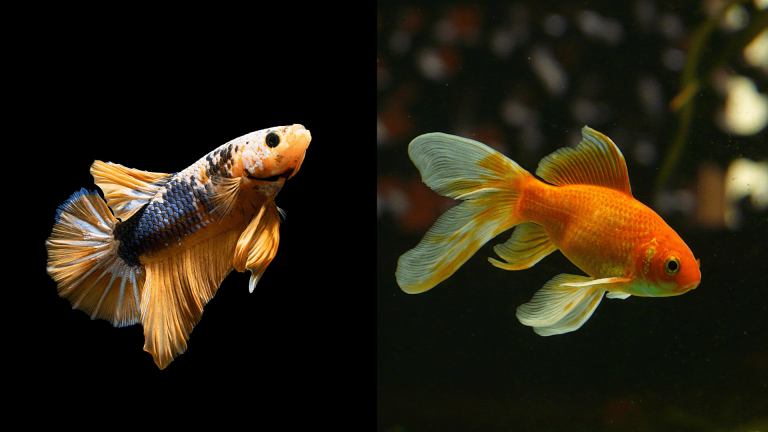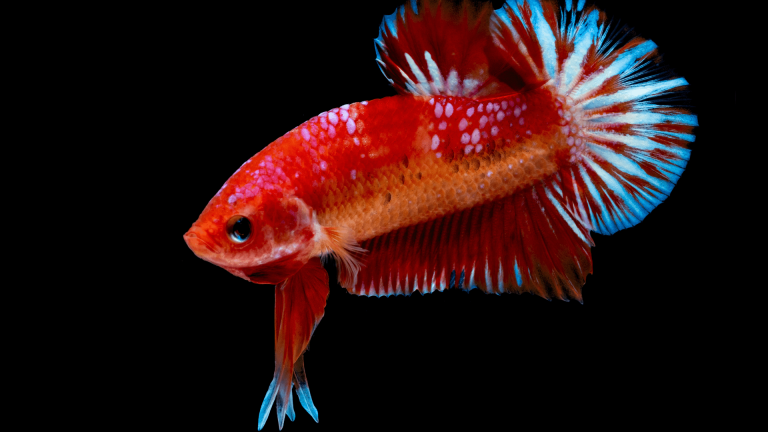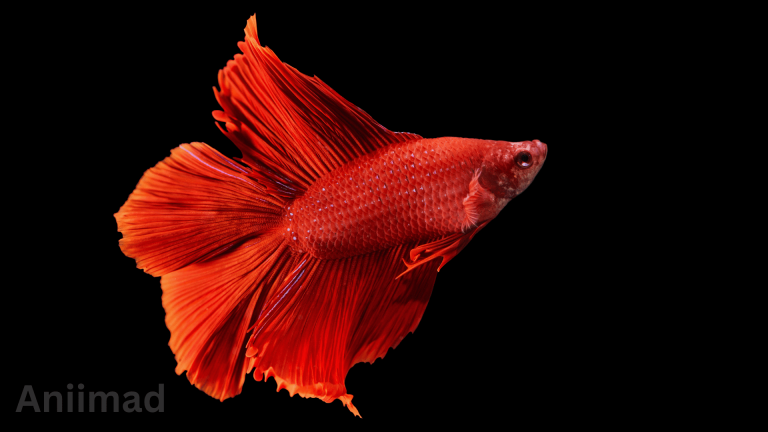The Ultimate Guide to Betta Fish Tank Setup for a Happy and Healthy Pet
Creating the perfect habitat for your betta fish is essential to ensure their well-being and overall happiness. A well-designed betta fish tank setup, provides a comfortable living space, enhances their natural behaviors, and promotes their overall health. This comprehensive guide will walk you through the key considerations and steps to set up an ideal betta fish tank.
How Do You Setup a Betta Fish Tank Setup for Beginners?

Setting up a betta fish tank for beginners can be an exciting and rewarding experience. Here is a simplified step-by-step guide to help you get started:
01. Tank Selection
- Choose a tank size of at least 5 gallons. A larger tank provides better water stability and more space for your betta to swim.
- Consider an aquarium kit with essential equipment such as a filter and heater for convenience.
02. Tank Placement
- Find a suitable location away from direct sunlight and drafts. A stable room temperature is ideal for bettas.
- Place the tank on a sturdy, level surface that can support its weight when filled with water.
03. Tank Setup
- Rinse the tank and all decorations thoroughly with water to remove any dust or debris.
- Add a substrate layer (fine-grained gravel or sand) to the bottom of the tank. Make sure it is clean and evenly spread.
04. Water Conditioning
- Fill the tank with dechlorinated water at room temperature. To get rid of hazardous compounds like chlorine, use a water conditioner.
- Allow the water to sit for a few hours to reach the ambient temperature before proceeding.
05. Decorations and Plants:
- Add aquarium-safe decorations such as caves, rocks, or ornaments. These will provide hiding places and stimulation for your betta.
- Consider adding live or silk plants to mimic the natural environment. Ensure they are non-toxic and suitable for aquarium use.
06. Heater and Thermometer

- Install an adjustable heater in the tank to maintain a stable temperature between 76-82°F (24-28°C), which is ideal for bettas.
- Attach a reliable thermometer to monitor and ensure the water temperature remains within the recommended range.
07. Filter Setup
- Install a gentle, low-flow, or sponge filter to maintain water quality.
- Ensure the filter correctly cycles before introducing your betta to the tank. Follow the manufacturer’s instructions for setup and maintenance.
08. Tank Cycling
- Cycling the tank establishes beneficial bacteria that convert toxic ammonia into less harmful substances.
- Research fishless cycling methods or consider using helpful bacteria supplements to expedite cycling.
09. Introducing Your Betta
- Acclimate your betta to the tank by floating their bag or container for 15-20 minutes. Small amounts of tank water should gradually add to the bag.
- Gently release your betta into the tank. Avoid sudden movements and ensure a smooth transition.
10. Feeding and Maintenance
- Feed your betta a high-quality betta-specific pellet food. Offer small portions 2-3 times daily, adjusting the quantity based on their appetite.
- Remove any uneaten food after a few minutes to maintain water cleanliness.
- Perform regular water changes of 25-30% weekly or 50% every other week to maintain good water quality.
- Monitor your betta’s behavior, appearance, and water parameters to ensure their well-being.
Remember, proper care, regular maintenance, and monitoring are essential for the health and happiness of your betta fish. Enjoy observing and interacting with your beautiful aquatic companion as they thrive in their new home.
What is a betta Fish Ideal Tank Setup?

An ideal tank setup for a betta fish should aim to replicate its natural habitat while providing a comfortable and stimulating environment. Here are the key elements to consider:
01. Tank Size
Opt for a tank with a minimum capacity of 5 gallons. Larger tanks, such as 10 gallons or more, are even better as they provide more swimming space and water stability for your betta.
02. Tank Shape
A rectangular tank is preferable over a bowl or round tank, as it offers more surface area for oxygen exchange and allows for better water circulation.
03. Water Temperature
Maintain the temperature between 76-82°F (24-28°C). Use a reliable heater with an adjustable thermostat to ensure a consistent and suitable temperature for your betta.
04. Filtration
Install a gentle filter with adjustable flow settings or a sponge filter to maintain water quality. Bettas prefer calm water, so choose a filter that minimizes water movement and doesn’t create strong currents.
05. Substrate
Use a fine-grained substrate like sand or gravel. Avoid rough or sharp-edged substrates that may damage your betta’s delicate fins. A depth of 1-2 inches is sufficient.
06. Decorations
Include hiding places and resting spots for your betta. Use smooth decorations like caves, tunnels, or plants to create a sense of security. Live or silk plants provide additional cover and mimic their natural environment.
07. Lighting

Provide a consistent light schedule of 10-12 hours daily. Use a timer to automate the lighting. Bettas benefit from a regular day-night cycle, so having a natural light source near the tank is also beneficial.
08. Water Quality
Perform regular water changes to maintain optimal water quality. Replace 25-30% of the water weekly or 50% every other week, depending on the tank size. Use a de-chlorinator to remove harmful chlorine and chloramines from tap water.
09. Tankmates
Bettas are generally solitary fish and can be aggressive towards tankmates. If you choose to have tankmates, select peaceful species that won’t nip at their fins. Snails, shrimp, or small schooling fish like tetras can be suitable but constantly monitor their interactions closely.
10. Feeding
Offer a varied diet of high-quality betta pellets supplemented with occasional treats like frozen or live foods. Feed small portions 2-3 times daily, adjusting the quantity based on their appetite. Remove any uneaten food to maintain water quality.
Monitoring water parameters, observing your betta’s behavior, and addressing any issues are crucial for their well-being. Remember to create a stimulating and enriching environment to keep your betta happy and healthy.
How Big of a Tank Does a Betta Fish Need?

Betta fish thrive in tanks that provide sufficient space for swimming and promote water stability. While bettas often keep in small bowls or tanks, providing them with a larger tank is recommended for optimal health and well-being.
A minimum tank size of 5 gallons (19 liters) usually advises for a single betta fish. However, providing a larger tank is even better. Tanks of 10 gallons (38 liters) or more offer more swimming space, allow for better water quality management and provide an environment closer to their natural habitat.
In a larger tank, bettas can exhibit more natural behaviors, have room to explore, and benefit from improved water conditions. They also experience less stress due to increased water volume and stability. Therefore, provide as much space as possible within your resources and ensure the tank is appropriately equipped and maintained.
Do Bettas Need a Bubbler?

Bettas do not necessarily require a bubbler or an airstone in their tank. Unlike other fish species, bettas have a specialized ability to breathe air from the water’s surface due to a labyrinth organ. They can obtain the oxygen they need directly from the perspective.
However, there are a few situations where a bubbler or air stone can be beneficial:
01. Oxygenation
If you have a heavily planted tank or the tank has limited surface agitation, a bubbler can help improve oxygen exchange at the water’s surface. It can benefit tanks with high stocking levels or warmer climates with lower oxygen levels.
02. Water Circulation
A gentle bubbling action can help water circulation in the tank, preventing stagnation and maintaining a more even distribution of heat and nutrients. It can also help distribute any beneficial bacteria present in the tank.
03. Aesthetic Purposes
Some people enjoy the look and sound of bubbles in their aquarium. If you find it visually appealing or calming, adding a bubbler can enhance the overall aesthetics of the tank.
When using a bubbler, it’s essential to consider the needs and preferences of your specific betta. Some bettas may be sensitive to strong water currents created by the bubbler, so it’s crucial to adjust the flow or position of the airstone to minimize the disturbance. Providing hiding spots and areas with calmer water can also help your betta if they prefer to rest away from the bubbles.
Ultimately, the decision to use a bubbler in a betta tank is bass on personal preference and the specific needs of your betta. As long as the water is oxygenated correctly, the tank is appropriately sized, and the betta is healthy and comfortable, a bubbler may or may not be necessary.
Here are Some Frequently Asked Questions About the Betta Fish Tank Setup
What is the minimum tank size for a betta fish?
A betta fish’s minimum recommended tank size is 5 gallons (19 liters). However, providing a larger tank, such as 10 gallons or more, is even better for their well-being.
Can I keep a betta fish in a bowl?
While bettas often stay in bowls, it is not ideal for long-term health. Bowls typically lack adequate space and proper filtration, leading to poor water quality and stress for the betta. It recommends providing a tank with a minimum of 5 gallons.
Should I use a filter in my betta fish tank?
A filter in a betta fish tank is highly recommended. A filter helps maintain water quality by removing debris and toxins, providing a healthier environment for your betta. Opt for a gentle or sponge filter to minimize water flow and prevent damage to the betta’s delicate fins.
Do betta fish need a heater?
Betta fish are tropical and require a stable water temperature between 76-82°F (24-28°C). It is crucial to use a reliable heater with an adjustable thermostat to maintain the optimal temperature range in the tank.
Can I keep other fish with my betta?
Betta fish are generally solitary and aggressive towards tankmates, especially other bettas or fish with long, flowing fins. However, some peaceful species can coexist in larger, well-planted tanks with bettas. Research compatible tankmates, such as tiny snails, shrimp, or peaceful bottom-dwelling fish, and monitor their interactions closely.
Do betta fish need a bubbler or an air stone?
Bettas have a labyrinth organ and can breathe air from the water’s surface, so a bubbler or airstone is unnecessary for their oxygen requirements. However, a bubbler can help improve oxygen exchange and water circulation in the tank, especially in heavily planted setups or tanks with little surface agitation.
Should I use live plants or artificial decorations in my betta fish tank?
You can use artificial decorations safe for aquariums and live plants in a betta fish tank. Live plants offer additional benefits such as oxygenation, natural cover, and a more natural environment. Silk plants are also an excellent alternative to provide hiding spots without the risk of sharp edges that some plastic decorations may have.
How often should I change the water in a betta fish tank?
Regular water changes are crucial for maintaining good water quality. It recommends replacing 25-30% of the water weekly or 50% every other week, depending on the tank size. Adjust the frequency and amount based on the specific needs of your tank and the water parameters.
What should I feed my betta fish?
Betta fish should feed a balanced diet of high-quality betta-specific pellets. Supplement their diet with occasional treats like frozen or live foods like bloodworms or brine shrimp. Feed small portions 2-3 times daily, adjusting the quantity to prevent overfeeding and maintain water cleanliness.
How can I tell if my betta fish is healthy and happy?
A healthy betta fish will exhibit vibrant colors, clear eyes, and active swimming behavior. They should have a good appetite and show interest in their surroundings. Be observant of any signs of lethargy, loss of appetite, abnormal behavior, or physical abnormalities, as these could indicate health issues that require attention.
Conclusion
In conclusion, providing a suitable tank setup is crucial for the health and well-being of betta fish. A tank size of at least 5 gallons or more advise to ensure an appropriate swimming room and encourage water stability. Maintaining the proper water temperature between 76-82°F (24-28°C) using a reliable heater is essential.
A gentle or sponge filter helps maintain water quality by removing debris and toxins. While bettas can breathe air from the water’s surface, a bubbler or air stone can aid in oxygenation and water circulation if desired.
Both live plants and aquarium-safe artificial decorations can use to provide hiding places and create a stimulating environment. Regular water changes, typically 25-30% weekly or 50% every other week, are necessary to ensure good water quality.
Feeding a balanced diet of high-quality betta-specific pellets, supplemented with occasional treats, helps keep bettas healthy. Monitoring their behavior, appetite, and overall appearance is vital to ensure they are thriving.
Remember, each betta fish is unique, so tailoring the tank setup to their specific needs and preferences is essential. Providing a comfortable, clean, and enriching environment will contribute to the longevity and happiness of your betta fish.






